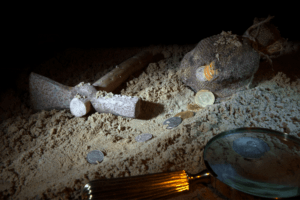
From ancient times till the present day we hear of fabulous hidden and long-lost treasures that have left behind enormous wealth.
Beyond the gold, the fabulous fortunes, and the hot mysteries, there is something more important behind these lost treasures, namely history! Here are ten of the world’s greatest undiscovered mythical treasures of all time:
1. The Lost Treasure Of The Egyptian Pharaohs
When Howard Carter discovered Tutankhamun’s tomb in the Valley of the Kings, the archaeologist was amazed by the splendor of the artifacts that accompanied the young pharaoh to the other side.
A huge treasure trove was found near the burial chamber, and it took Carter ten years to finish cataloging the artifacts. However, when other burial chambers of more prominent pharaohs were discovered in the 19th century, their treasure chambers were almost empty.
Tomb robbers have been known to steal these treasures over the centuries, but it’s hard to believe that mere thieves emptied entire tombs altogether. And then we are left to wonder where is the vast wealth of the pharaohs buried in the Valley of the Kings.
Some scholars believe that the wealth passed into the ownership of the priests who conducted the reburials in the Valley of the Kings between 425-343 BC. One name, in particular, stands out, namely Herihor, a high court official during the reign of Rameses XI.
Upon Rameses’ death, Herihor usurped the throne, dividing the kingdom with a co-conspirator, his son-in-law Piankh. Herihor declared himself responsible for the reburial procedure in the Valley of the Kings, which gave him the opportunity to appropriate treasures on a grand scale. His tomb was never found.
When it is found, if indeed it exists, many scholars believe that the riches of Egypt’s great pharaohs will finally see the light of day. This is believed to be one of the greatest undiscovered treasures of all time.
2. The Treasure of Montezuma
The Spanish decimation of the Aztec Empire in Mexico took place in 1520. After the mortal wounding of Emperor Montezuma, Hernando Cortés and his men were besieged by Aztec warriors in the capital Tenochtitlán.
After long days of fierce fighting, Cortés ordered his men to take Montezuma’s great treasure and leave with it during the night, but they didn’t get far as the Aztecs caught up with him. The carnage that took place is said to have filled Lake Tezcuco with the bodies of the Spaniards and Montezuma’s riches.
The terrified army threw away the treasure in an attempt to escape with their lives. The treasure consisted of numerous gold and silver ornaments, along with a vast array of jewelry.
Cortés and a handful of his men escaped with their lives and returned a year later to seek revenge. When the inhabitants of Tenochtitlán learned of the approaching invaders, they buried the remains of the city’s treasure in and around Lake Tezcuco.
Some of the remains of the treasure that had been hidden for nearly five centuries were found on the outskirts of Mexico City, the modern incarnation of the capital Tenochtitlán. Generations of treasure hunters have searched for this mythical long-lost treasure but without success, making it one of the greatest undiscovered riches of all time.
3. The Enormous Treasure Of King Decebal Of Dacia
The existence of King Decebal’s treasure is one of the most fascinating enigmas of Romanian history. It stems from claims by the Roman historian Dio Cassius that the Roman conquest of Dacia also revealed Decebal’s treasures, which were hidden under the Sargetia River near his capital.
The Roman historian says that Decebal “lowered the river with the help of prisoners and dug a pit there. He put in it a huge amount of silver and gold, and other very precious things, and then he brought the river back to its bed. Also with the help of prisoners, he put garments and other less precious things in the caves. But Bicilis, a companion of his who knew the secret, was taken prisoner and revealed all of this.”
Romanian historian Nicolae Iorga also writes that “the Dacian monarch, in the last mountain shelter, after hiding in caves some of the treasures he had long gathered, had the last meal with his last companions”.
Last but not least, a scene on the Thracian Column depicts a Roman column of animals carrying Dacian treasures. Some historians believe it to be Decebal’s hoard discovered in the bed of the Sargetia (Sargetica) river, according to some specialists the actual course of the river Strei.
Most archaeologists regard Cassius’ claims as a legend originally taken from Diodorus of Sicily. The Byzantine writer Ioanes Lydus, in his work “De Magistratibus”, based on Crito’s, estimates this great treasure at 165,000 kilograms of gold and 331,000 kilograms of silver, as well as valuable vessels, and glassware.
Jerome Carcopino, a professor at the Faculty of Letters of the University of Paris, said the famous treasure is worth a total of 62,200,000 gold francs.
Although many of the figures that have been put forward have been considered exaggerated, they nevertheless give a suggestive picture of the wealth of Dacia, in which the royal hoard could well have been included, and which contributed greatly to the resolution of the financial crisis in the Roman Empire and to the completion of some great constructions. But no one looked for King Decebal’s hoard on the ground.
4. The Ark Of God
For the Israelites, the Ark of God was one of the most sacred things in the world. The disappearance of the Ark of the Law has captivated countless scholars around the world. Since there is no mention of its destruction, people have always sought to unravel this great mystery.
The Ark has served as a holy archive for the preservation of sacred relics, including the two tablets of the Ten Commandments. Historically and religiously, the Ark and its contents are priceless.
In 607 BC, the Babylonians conquered Jerusalem, the capital of Israel, and the site of the Ark in Solomon’s Temple. More than a million people died in the slaughter. Seventy years later, when the Israelites returned to the city, the Ark was gone. What happened to it is one of the most speculated-upon topics even today.
One widespread hypothesis is that the Jews hid the Ark from the Babylonians inside Mount Nebo in Egypt, or in Ethiopia, in a cave. However, if the artifact was hidden, why wasn’t it brought back when the temple was rebuilt? Others believe that the Babylonians’ violent attack destroyed the Ark.
This is one of the world’s greatest mysteries and one of the greatest undiscovered treasures of all time.
5. The Treasure Of The Knights Templar
The Knights Templar was a religious order formed in 1119 to protect Christian pilgrims on their forays into the Middle East. Over time, the Knights Templar received numerous donations, making them a very powerful military and religious order. They even invented a medieval form of a bank, offering loans with interest.
The Knights Templar declined, and in 1307 King Philp VI of France arrested the order’s leaders and decided to confiscate their wealth. However, the envoys found little in the Order’s treasury. Legend has it that the other Templars hid the treasure in many parts of Europe.
No one knows what happened to the other knights who were not arrested, and the Order’s legendary fortune remains a mystery that has never been solved. It is definitely one of the greatest undiscovered treasures of all time.
6. Captain Kidd’s Loot
William Kidd was a Scottish sailor, originally a pirate hunter. Theoretically, he was supposed to stop piracy, but he did exactly the opposite as he was tempted by pirate gold. After amassing quite a fortune, he was arrested upon his return from the Indian Ocean in 1699. Kidd was tried and executed in 1701.
But what has never been discovered is the fortune that should have proved his deeds. Only one of his caches was discovered on Gardener’s Island in New York and the treasure was sent to England to be used as evidence of his guilt during his trial. The idea that he had other secret places to hide his loot has never been proven, but the hope that these places still exist sends men searching for them, armed with shovels.
It seems that one of the places would be somewhere on Clarke’s Island along the Connecticut River. Legend has it that the gold must be unearthed by three people, in complete silence, during a full moon, pouring its light right overhead. There is a legend about three men who followed the “directions” almost to the end. But once the treasure began to surface, one of them cried out, “We did it!”. With the rule of silence broken, the treasure sank into the sand and could not be found. Legends…
7. The Blackbeard Pirate’s Treasure
While we’re on the subject of pirates, the story of the famous pirate Blackbeard should be included.
Edward Teach, also known as Blackbeard, spent only two years (1716-1718) plundering the seas and ships that came his way. Although the time was short, it was enough to amass a huge treasure. While the Spanish were busy grabbing gold and silver from Mexico and South America, Blackbeard and his comrades waited patiently, then pounced on the treasure-laden ships, plundering the Spaniards as they returned home. Blackbeard soon became the most feared pirate, earning a reputation as a cruel and greedy opportunist.
He ruled by terror over the West Indies and the Atlantic coast of North America, with headquarters in both the Bahamas and North Carolina. He met his end in November 1718, when British Lieutenant Robert Maynard beheaded him and hung his head on his ship as a trophy.
Blackbeard admitted to his executioners that he had hidden his treasure, but did not reveal where. This has led countless treasure hunters to search for it, even to this day. Blackbeard’s sunken ship, Queen Anne’s Revenge, is believed to have been discovered in 1996 near Beaufort, North Carolina, but the cargo was not on board.
The treasure could be hidden somewhere in the Caribbean, in Virginia’s Chesapeake Bay, or in caves in the Cayman Islands. Though no one has been able to find it, many are still searching.
The story of the pirate Blackbeard was the inspiration for the writers of the Pirates of the Caribbean trilogy.
8. The Amber Room
Many consider The Amber Room the eighth wonder of the world. Made of amber slabs, polished with gold leaf, it was created by German and Russian craftsmen in the early 18th century and presented by Prussian King Friedrich Wilhelm I to his Russian ally Tsar Peter the Great in 1716 as a symbol of friendship, following exemplary diplomatic relations between the two countries.
This amber chamber was intended for the safekeeping of valuables, so it functioned as a very valuable vault in itself. It was designed by Andreas Schutler and built in the Charlottenburg Palace in Prussia between 1701 and 1709.
The impressive chamber, which would now be worth more than $200 million, disappeared without trace during the Second World War and has been one of the most hunted treasures ever since.
Officially, it was said to have been destroyed in an Allied bombing raid, but legend has it that the Nazis moved it and hid it.
Only a small piece of the amber plate that lined the entire chamber was recovered in 1997. A Bremen lawyer who had got hold of the precious piece tried to sell it to a former naval officer. Fortunately, he was part of a group of archaeologists who had been trying to find the remains of the chamber for several years, and so the piece ended up in the custody of a museum in Russia.
Convinced that they could not find it, the historians and archaeologists decided to reconstruct it. The restoration work began in 1980, with specialists trying to recreate the Chamber from photographs, memories, descriptions, and remains of the original.
9. The Fortune Of Dutch Schultz
Dutch Schultz (born Arthur Flegenheimer) was a New York mobster in the 1920s and 1930s. Over the course of his criminal career, he amassed a huge fortune from his business dealings. The government continually tried to catch him for his crimes but without any success. Eventually, the authorities had to use the same charge as for Al Capone: tax evasion.
Schultz, knowing he was going to prison, figured he would need some “pocket change” when he got out. He took $7 million in cash and buried it in a hidden location in upstate New York. Aside from Schultz, only two of his bodyguards knew the location. Unfortunately, both were shot before he arrived at the prison, and Schultz died shortly afterward of an infection.
Although there is no evidence that the mobster revealed the location before his death, some people say the fortune may be hidden in a forest in Phoenecia Park.
10. Treasures Of Lima
In 1920s Peru, Lima was on the verge of revolt. As a precaution, the city’s viceroy decided to move the riches to Mexico for safekeeping. So precious stones, two life-size gold statues of the Virgin Mary with the Christ Child, and more filled 11 ships, worth tens of millions of dollars.
The Viceroy gave command of the transport to the master William Thompson of the Dear Mary, who turned out to be a ruthless pirate. He steered the ships to Cocos Islands in the Indian Ocean, where he is said to have buried the treasure.
The “Dear Mary” was captured by the Spanish and all the sailors except Thompson and his mate were hanged. The two led the jailers to the Cocos Islands, where they managed to escape into the jungle. Neither they nor the treasure was ever seen again.
Since then, more than 300 expeditions have tried unsuccessfully to find the Lima treasure.





































